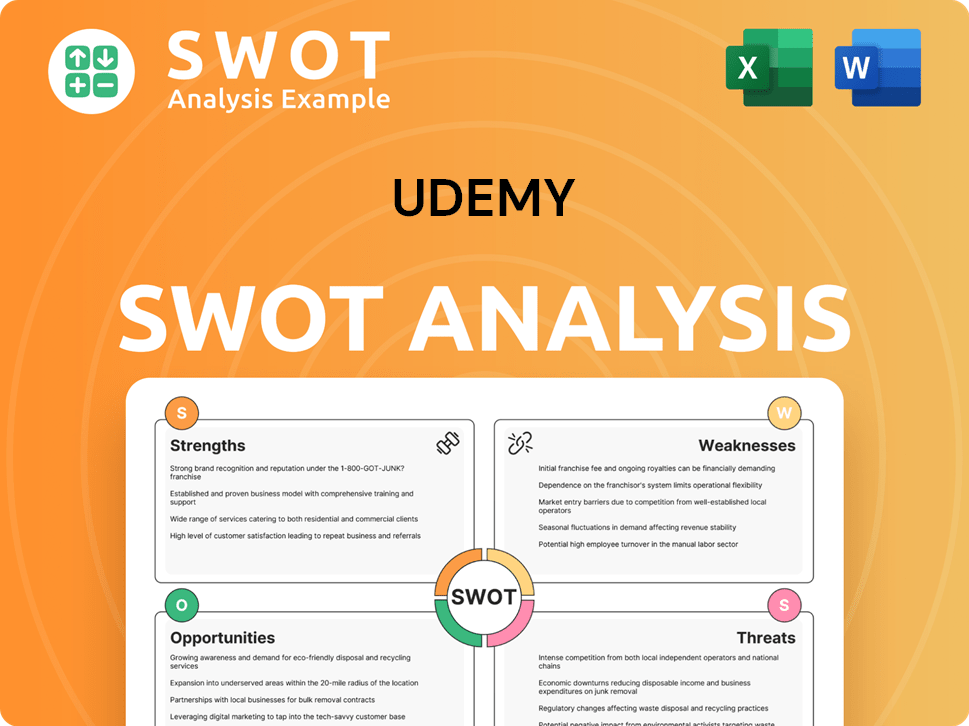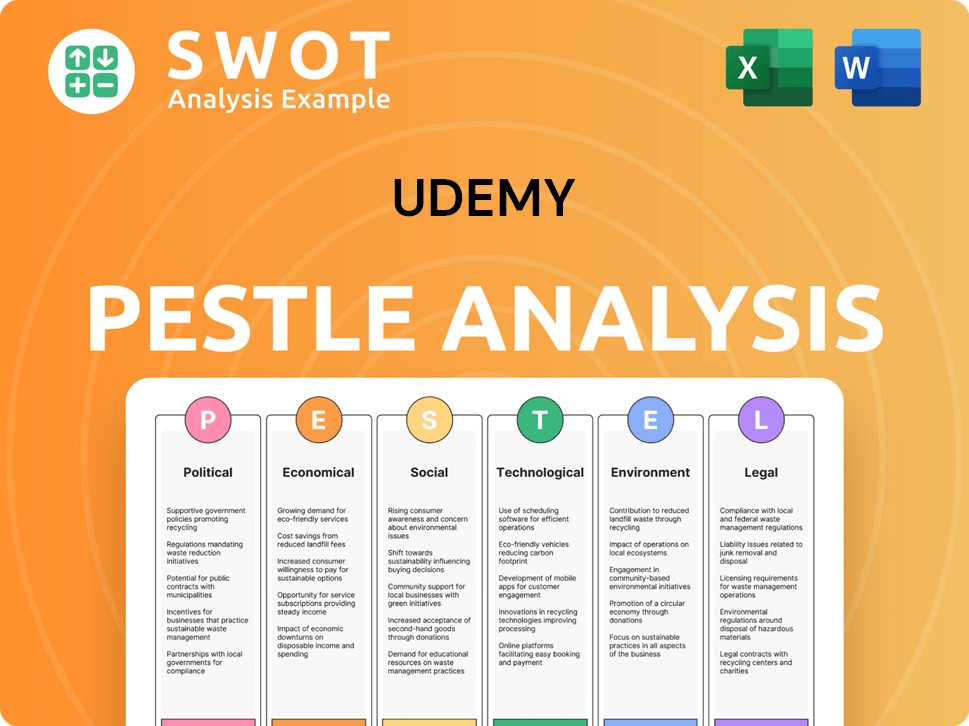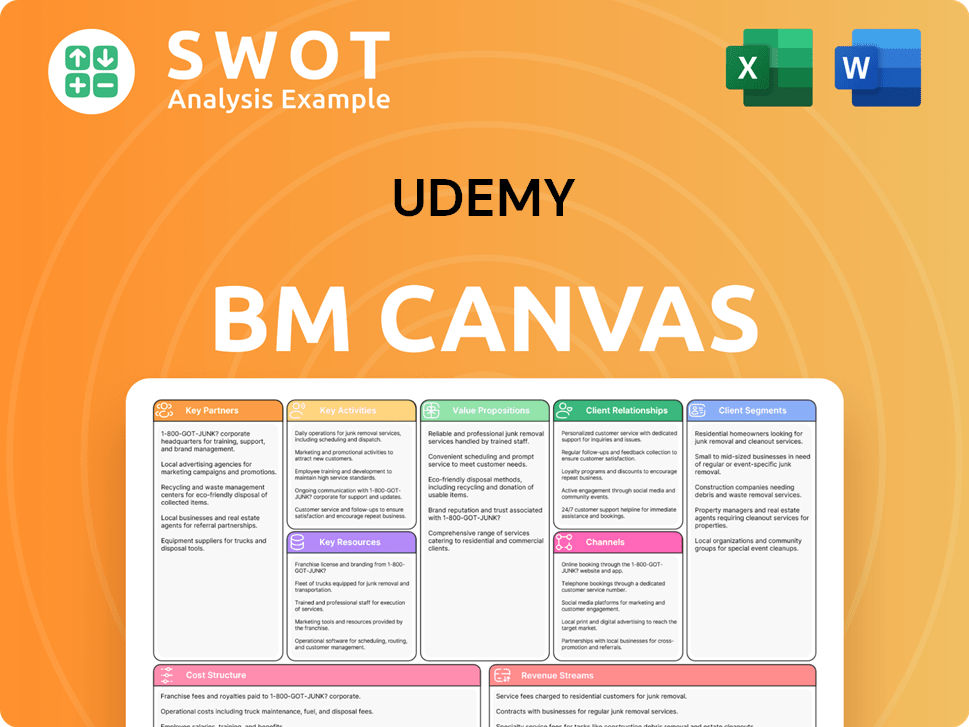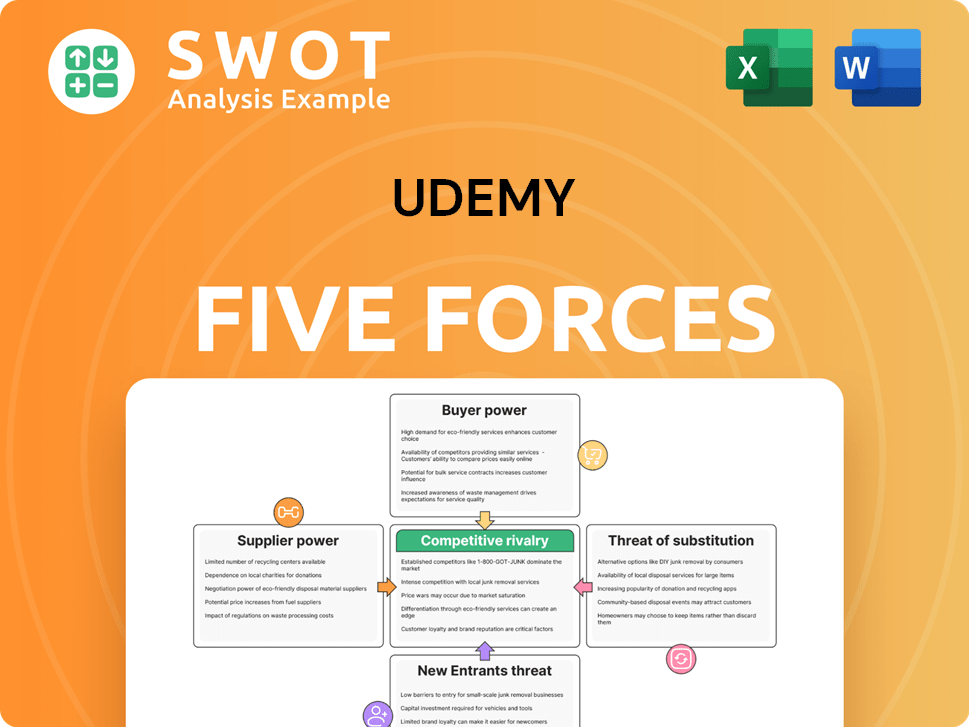Udemy Bundle
How Did Udemy Become a Global E-Learning Giant?
Born from a simple idea in Turkey, the Udemy SWOT Analysis reveals a fascinating journey. From a live virtual classroom concept in 2007 to a Silicon Valley startup in 2010, the Udemy company's evolution is a story of vision and adaptation. Discover how Udemy, founded by Eren Bali and Oktay Caglar, revolutionized online learning.

The Udemy platform's early days, driven by a mission to democratize education, saw rapid growth. With nearly 80 million learners as of early 2025, Udemy's impact on education is undeniable. Explore the key milestones and strategic shifts that have defined Udemy's growth over time, and understand how the company has achieved a revenue of $786.6 million in 2024.
What is the Udemy Founding Story?
The story of the Udemy company began on May 11, 2010. It was the brainchild of Eren Bali, Gagan Biyani, and Oktay Caglar. Their vision was to create a platform where anyone could learn and teach, thus democratizing education.
Eren Bali's background significantly shaped the company's mission. Growing up in a Turkish village, he understood the limitations of traditional education. He, along with his co-founders, aimed to solve the problem of limited access to diverse knowledge. They wanted to create a space where experts could share their skills and earn money.
The initial journey wasn't easy. The founders faced numerous rejections when seeking venture capital. Despite these setbacks, they persevered, bootstrapping the product's development. This determination led to the launch of the Udemy platform in May 2010.
The early days of Udemy were marked by both challenges and successes, shaping its trajectory in the online learning space.
- The founders faced rejection from investors initially, but they didn't give up.
- They bootstrapped the development and launched the platform in May 2010.
- To prove their business model, the team created a course that generated $30,000 in a few weeks.
- This success attracted the first 1,000 instructors and nearly 10,000 registered users within months.
The initial business model was a marketplace where instructors could host and sell their courses directly to students. An interesting anecdote from their early days involves the team creating their own course as a case study, which generated $30,000 within a few weeks, proving the viability of their model and attracting the first 1,000 instructors who collectively created around 2,000 courses. This early success, coupled with nearly 10,000 registered users within months, enabled them to raise $1 million in venture funding by August 2010.
The founders' persistence paid off. The success of their initial course offerings and the rapid growth in user registration demonstrated the viability of their model. This early validation allowed them to secure $1 million in venture funding by August 2010, setting the stage for further growth. To read more about the company's evolution, you can explore a detailed overview of the company's history by clicking here: 0.
Udemy SWOT Analysis
- Complete SWOT Breakdown
- Fully Customizable
- Editable in Excel & Word
- Professional Formatting
- Investor-Ready Format

What Drove the Early Growth of Udemy?
The early growth of the Udemy company was marked by rapid expansion and a growing user base, transforming it from an initial concept into a major player in online education. The Udemy platform quickly gained traction after its launch in May 2010, attracting a significant number of instructors and users within months. This period was characterized by the continuous addition of new course categories and the introduction of features aimed at enhancing the learning experience.
Within months of its launch, the Udemy platform attracted 1,000 instructors and 10,000 registered users. By 2014, the platform had reached one million learners. The platform expanded its course offerings beyond technology and business to include arts and personal development.
In 2015, Udemy launched Udemy Business, a subscription-based service focused on corporate training. This strategic shift targeted the business-to-business (B2B) segment, complementing its direct-to-consumer (B2C) marketplace. This segment's growth significantly outpaced the Consumer segment.
Udemy Business revenue reached $120.6 million in 2024, compared to the Consumer segment's $73.8 million. By 2024, Udemy Business contributed 60% of the total revenue, a substantial increase from 18% in 2019. The company's adaptive approach to market reception and competitive pressures solidified its position in the online education landscape.
Early customer acquisition strategies included leveraging internal courses to inspire instructors and expanding the course catalog. The COVID-19 pandemic accelerated Udemy's growth, with a 425% rise in user enrollments in 2020. In early 2024, Udemy had 75 million learners and approximately 250,000 courses. You can learn more about the Marketing Strategy of Udemy.
Udemy PESTLE Analysis
- Covers All 6 PESTLE Categories
- No Research Needed – Save Hours of Work
- Built by Experts, Trusted by Consultants
- Instant Download, Ready to Use
- 100% Editable, Fully Customizable

What are the key Milestones in Udemy history?
The Udemy company has experienced a dynamic journey, marked by significant milestones that have shaped its evolution in the online learning landscape. From its inception to its current standing, the Udemy platform has navigated various phases of growth and adaptation.
| Year | Milestone |
|---|---|
| October 29, 2021 | Initial Public Offering (IPO) on Nasdaq under the symbol UDMY. |
| November 2024 | Launched AI-powered Skills Mapping feature. |
| 2025 | Hugo Sarrazin replaced Gregg Coccari as CEO. |
A key innovation for the Udemy platform has been the development of its AI-powered Skills Mapping feature, which launched in November 2024. This feature has been adopted by over 1,800 enterprise customers, with more than a third of learning paths created using this capability.
The AI-powered Skills Mapping feature, launched in November 2024, helps personalize and drive outcomes in skills development. This innovation has been recognized as a Strategic Leader in the 2025 Fosway 9-Grid™ for Digital Learning.
Udemy has cultivated strategic partnerships, including being recognized as the 2024 Rising Star Partner of the Year in North America by Amazon Web Services. These collaborations enhance the platform's capabilities and reach.
Despite its successes, the Udemy company has faced challenges, including strategic restructuring and changes to its revenue model. The company implemented layoffs in 2023 and 2024 to save between $30 million and $32 million annually.
Changes to the instructor revenue share model, effective January 2024, reduced the share for subscription models from 25% to 20%, with further reductions planned. This model adjustment aimed to increase gross profit, which grew by 17% to $491.9 million in 2024.
The Consumer segment experienced a 5% decline in revenue in 2024, attributed to shifting market trends and reduced discretionary spending. The company has focused resources upmarket to better serve large enterprise customers.
In 2025, Hugo Sarrazin took over as CEO, succeeding Gregg Coccari. This leadership change reflects the company's strategic pivots and efforts to adapt to evolving market dynamics.
Udemy Business Model Canvas
- Complete 9-Block Business Model Canvas
- Effortlessly Communicate Your Business Strategy
- Investor-Ready BMC Format
- 100% Editable and Customizable
- Clear and Structured Layout

What is the Timeline of Key Events for Udemy?
The Udemy company has a fascinating history, starting with its roots in a virtual classroom concept developed in Turkey. From facing initial investor rejections to becoming a publicly traded company, Udemy's journey reflects the evolution of online learning and its impact on the e-learning landscape.
| Year | Key Event |
|---|---|
| 2007 | Eren Bali and Oktay Caglar developed a live virtual classroom in Turkey, marking the initial concept. |
| Early 2010 | Eren Bali, Oktay Caglar, and Gagan Biyani founded Udemy in Silicon Valley. |
| May 2010 | Udemy officially launched after facing multiple rejections from investors. |
| August 2010 | Udemy secured $1 million in venture funding. |
| 2014 | The platform reached one million learners and launched its mobile app. |
| 2015 | Udemy Business, the enterprise learning solution, was launched. |
| 2020 | Udemy was recognized on Fortune Magazine's 'Change the World' List, and the COVID-19 pandemic drove significant growth in user enrollments. |
| October 29, 2021 | Udemy held its Initial Public Offering (IPO) and listed on Nasdaq as UDMY. |
| February 2023 | Udemy laid off 10% of its employees. |
| November 2023 | Udemy announced changes to its instructor revenue share model, effective January 2024. |
| 2024 | Udemy's total revenue reached $786.6 million, with Udemy Business revenue growing 18% to $494.5 million, and the platform attracts 8 million new learners, bringing the total to 77 million. |
| September 2024 | Udemy announced a strategic restructuring plan, impacting approximately 280 global employees. |
| February 2025 | Hugo Sarrazin replaced Gregg Coccari as CEO. |
| March 2025 | Udemy was recognized as a Strategic Leader in the 2025 Fosway 9-Grid™ for Digital Learning. |
| April 30, 2025 | Udemy reported Q1 2025 results, with total revenue exceeding $200 million for the first time at $200.3 million. |
For the full year 2025, Udemy projects revenue to be between $787 million and $803 million. This indicates continued growth in the online learning market.
Adjusted EBITDA for 2025 is expected to be between $75 million and $85 million, demonstrating the company's focus on profitability.
Udemy plans to expand its international presence and increase market penetration. They are employing a 'land-and-expand' strategy to achieve these goals.
A key focus is leveraging generative AI to improve learner outcomes and content creation. AI-powered solutions like the Udemy AI Assistant and Skills Mapping are central to their strategy.
Udemy Porter's Five Forces Analysis
- Covers All 5 Competitive Forces in Detail
- Structured for Consultants, Students, and Founders
- 100% Editable in Microsoft Word & Excel
- Instant Digital Download – Use Immediately
- Compatible with Mac & PC – Fully Unlocked

Related Blogs
- What is Competitive Landscape of Udemy Company?
- What is Growth Strategy and Future Prospects of Udemy Company?
- How Does Udemy Company Work?
- What is Sales and Marketing Strategy of Udemy Company?
- What is Brief History of Udemy Company?
- Who Owns Udemy Company?
- What is Customer Demographics and Target Market of Udemy Company?
Disclaimer
All information, articles, and product details provided on this website are for general informational and educational purposes only. We do not claim any ownership over, nor do we intend to infringe upon, any trademarks, copyrights, logos, brand names, or other intellectual property mentioned or depicted on this site. Such intellectual property remains the property of its respective owners, and any references here are made solely for identification or informational purposes, without implying any affiliation, endorsement, or partnership.
We make no representations or warranties, express or implied, regarding the accuracy, completeness, or suitability of any content or products presented. Nothing on this website should be construed as legal, tax, investment, financial, medical, or other professional advice. In addition, no part of this site—including articles or product references—constitutes a solicitation, recommendation, endorsement, advertisement, or offer to buy or sell any securities, franchises, or other financial instruments, particularly in jurisdictions where such activity would be unlawful.
All content is of a general nature and may not address the specific circumstances of any individual or entity. It is not a substitute for professional advice or services. Any actions you take based on the information provided here are strictly at your own risk. You accept full responsibility for any decisions or outcomes arising from your use of this website and agree to release us from any liability in connection with your use of, or reliance upon, the content or products found herein.